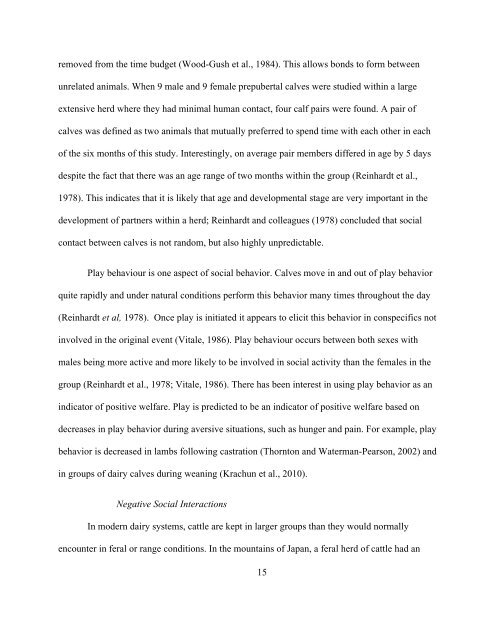Stanton PhD Thesis final_docx - Atrium - University of Guelph
Stanton PhD Thesis final_docx - Atrium - University of Guelph
Stanton PhD Thesis final_docx - Atrium - University of Guelph
Create successful ePaper yourself
Turn your PDF publications into a flip-book with our unique Google optimized e-Paper software.
emoved from the time budget (Wood-Gush et al., 1984). This allows bonds to form between<br />
unrelated animals. When 9 male and 9 female prepubertal calves were studied within a large<br />
extensive herd where they had minimal human contact, four calf pairs were found. A pair <strong>of</strong><br />
calves was defined as two animals that mutually preferred to spend time with each other in each<br />
<strong>of</strong> the six months <strong>of</strong> this study. Interestingly, on average pair members differed in age by 5 days<br />
despite the fact that there was an age range <strong>of</strong> two months within the group (Reinhardt et al.,<br />
1978). This indicates that it is likely that age and developmental stage are very important in the<br />
development <strong>of</strong> partners within a herd; Reinhardt and colleagues (1978) concluded that social<br />
contact between calves is not random, but also highly unpredictable.<br />
Play behaviour is one aspect <strong>of</strong> social behavior. Calves move in and out <strong>of</strong> play behavior<br />
quite rapidly and under natural conditions perform this behavior many times throughout the day<br />
(Reinhardt et al, 1978). Once play is initiated it appears to elicit this behavior in conspecifics not<br />
involved in the original event (Vitale, 1986). Play behaviour occurs between both sexes with<br />
males being more active and more likely to be involved in social activity than the females in the<br />
group (Reinhardt et al., 1978; Vitale, 1986). There has been interest in using play behavior as an<br />
indicator <strong>of</strong> positive welfare. Play is predicted to be an indicator <strong>of</strong> positive welfare based on<br />
decreases in play behavior during aversive situations, such as hunger and pain. For example, play<br />
behavior is decreased in lambs following castration (Thornton and Waterman-Pearson, 2002) and<br />
in groups <strong>of</strong> dairy calves during weaning (Krachun et al., 2010).<br />
Negative Social Interactions<br />
In modern dairy systems, cattle are kept in larger groups than they would normally<br />
encounter in feral or range conditions. In the mountains <strong>of</strong> Japan, a feral herd <strong>of</strong> cattle had an<br />
15

















